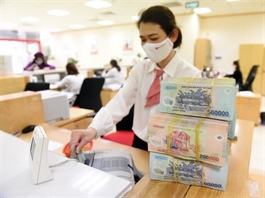Lenders accelerate bond issuance to entice fresh capital
Lenders accelerate bond issuance to entice fresh capital
As credit growth is expected to outpace last year, banks are facing barriers to raising deposit rates to entice savings and are increasingly turning to alternative funding channels, particularly bonds.
One month after a conference between the State Bank of Vietnam (SBV) and commercial banks to implement interest rate reduction measures, as of March 26, 24 domestic commercial banks have lowered deposit rates, with reductions ranging from 0.1 to 1.05 percentage points per annum, depending on the term.

Lending rates may remain low in order to support the economy, photo Le Toan |
In March, 19 banks had reduced their deposit rates, including VietinBank, Agribank, BIDV, and Techcombank. Among them, Eximbank cut rates four times and Kienlongbank three times, while PGBank and VRB adjusted rates twice.
Analysts from VCBS forecast that the SBV will maintain stable interest rate policies to align with the broader economic environment and macroeconomic targets.
“The SBV may instruct commercial banks to continue reducing lending rates by cutting costs, applying digital technology to lower expenses, and providing interest rate support for businesses and individuals. VCBS leans towards a scenario where deposit rates remain stable in the near term, while lending rates stay at low levels, though variations across industries are expected,” it said.
Meanwhile, Dinh Quang Hinh, head of Macroeconomics and Market Strategy at VNDirect Securities, expected deposit rates to remain stable at current levels and has revised his forecast for the average 12-month deposit rate down to 4.8-5 per cent per annum, from a previous estimate of 5.4 per cent, reflecting the SBV’s monetary easing stance to support economic growth.
“In an optimistic scenario, if the US Federal Reserve cuts policy rates 2-3 times this year, starting from its June meeting, SBV could consider lowering its benchmark rates by 25 basis points in Q3, including the refinancing rate, to boost credit growth and support Vietnam’s GDP growth target of 8 per cent for 2025,” added Hinh.
According to economist Nguyen Tri Hieu, lending rates may remain low to support economic recovery and facilitate business borrowing.
“There is limited room to further reduce lending rates to stimulate credit growth. However, if lending rates increase, capital absorption in the economy may slow, impacting credit growth. This presents a difficult balance for banks, which need to offer competitive lending rates while ensuring sufficient returns for depositors,” Hieu said.
According to statistics from the Vietnam Bond Market Association released on March 17, there have been nine public bond issuances in 2025, all with a distribution success rate exceeding 90 per cent.
VPS Securities led capital mobilisation in this segment, raising $200 million from nearly 1,800 individual and institutional investors. Following closely were banks such as VietinBank with $160 million, SHB with $94 million, MB with $88 million, and BVBank with $50 million.
Last week, ACB’s board of directors approved a plan for its first private bond issuance in 2025 ahead of its AGM on April 8.
Specifically, ACB plans to issue up to $800 million in non-convertible bonds in 2025 to support lending and investment activities. These bonds will be unsecured, non-convertible, without warrants, and will not constitute ACB’s subordinated debt.
“Bank bonds are highly rated, and many institutions seek to issue Tier 2 bonds to support credit growth, improve capital adequacy ratios, and minimise reliance on short-term funds for medium- and long-term lending,” said Hoang Viet Phuong, CEO of S&I Ratings.
VNDirect Securities, in its March investor report, highlighted that the SBV aims for a credit growth target of around 16 per cent in 2025 to support economic expansion. This target suggests that banks will continue to actively raise capital.
“In 2025, banks are expected to intensify private corporate bond issuances to strengthen their medium- and long-term capital bases, supporting the recovery of Vietnam’s corporate bond market. The issuance of long-term private bonds, similar to trends seen in 2024, will not only help banks bolster their capital but also ensure compliance with SBV regulations on short-term funding limits for medium- and long-term lending,” the report stated.
Phan Duy Hung, director and senior analyst at VIS Rating, estimated that banks would need approximately $11.3 billion in Tier 2 capital bonds over the next 1-3 years. This capital will help financial institutions meet internal capital requirements and maintain capital adequacy ratios.
“As commercial banks adopt international standards such as Basel II and III, they will need to strengthen their capital buffers in the coming years. VIS Rating forecasts that the banking sector will issue over $11.3 billion in Tier 2 capital bonds within three years, with approximately 55 per cent of these issuances coming from state-owned banks,” Hung said.
“Some smaller banks with weaker profitability may issue Tier 2 bonds to improve capital adequacy ratios by 3-4 per cent. Meanwhile, mid- and large-sized private banks will utilise Tier 2 bonds to support high credit growth targets. The top five banks projected to lead Tier 2 bond issuance are BIDV, VietinBank, Agribank, MB, and HDBank,” added Hung.
- 11:58 02/04/2025





























